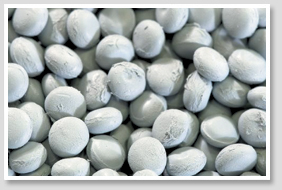Mineral modifiers offer polyolefin processors a wide range of options to improve their product properties cost effectively. To provide processors with a high-quality, extremely inexpensive mineral compound, Mikron'S has developed the MIKROLENE®product series with extremely high filler contents. MIKROLENE®PO contains 80 wt.-% calcium carbonate compounded with only 20 wt. % polymer. The calcium carbonate is a fine coated whiting. The carrier material is a special polyolefin. Handling, compounding and logistics costs are kept as low as possible to provide the market with a cost-effective high-quality product.
Property Changes Produced by MIKROLENE® PO  Rheology
Rheology
By virtue of the lower thermal expansion of the mineral, the addition of calcium carbonate reduces the volume of the mineralmodified polymer melt compared with pure polymer. Under constant processing conditions, this leads to a lower melt pressure as well as to a lower screw drive torque. As a consequence, the screw speed can be increased, and thereby the output increased.
Semi-crystalline polymers, such as PP and HDPE, have a very narrow processing window for thermoforming. Because of the relatively sharp crystalline melting point, there is only a very narrow temperature range between the elastomeric and lowviscosity state of the polymer melt. The addition of minerals increases the melt viscosity at the low shearing and stress rates encountered during thermoforming. Consequently there is a broader temperature range in which the material can be successfully re-formed. The benefit of this is more uniform wall thicknesses, particularly in the case of corrugated pipes.
 Young's Modulus and Stiffness
Young's Modulus and Stiffness
The use of calcium carbonate in PP or HDPE increases stiffness (Young's modulus) compared with the pure polymer. Stiffness number is particularly important for pipes. It is principally determined by:
- Young's modulus of the polymer
- Pipe wall thickness
- Average pipe diameter
- Pipe design
An increase in Young's modulus by means of MIKROLENE® PO thus directly increases the pipe's stiffness number. This permits the wall thickness to be reduced, leading to a significant reduction of material costs.  Thermal Conductivity
Thermal Conductivity
The high thermal conductivity of calcium carbonate means that the thermal energy supplied externally and generated during processing distributes faster through the material. This speeds up the melting of the polymer matrix during extrusion and improves dispersion of the minerals. Also, the melt-temperature is more homogeneous, without local hot spots resulting in a more uniform melt viscosity. This leads to more even wall thickness of corrugated pipes, particularly during thermoforming. Conversely, the thermal energy is also dissipated faster during cooling (cooling time is reduced).
| Material Thermal Conductivity | [W * m-1 * K-1] |
| PP | 0,2 |
| HDPE | 0,45 |
| Calcium carbonate (CaCO3) | 2,7 |
| PP + 20% CaCO3 | 0,42 |
| PP + 40% CaCO3 | 0,56 |
 Toughness
Toughness
Fine calcium carbonates improve the toughness of PPH. The formation of microcrazes at the calcium carbonate/polymer interface prevents premature fracture of the part. In the case of PPC and HDPE, the toughness properties are only slightly reduced.  Shrinkage Behaviour
Shrinkage Behaviour
Because of the almost spherical structure of the calcium carbonate, particle orientation is virtually impossible when MIKROLENE® PO is used. At contents of 30 % MIKROLENE® PO and more, shrinkage is virtually identical in the longitudinal and lateral directions. Internal stresses, and therefore the possibility of warping are largely prevented. In practice, this means that lowwarpage parts with low shrinkage can be produced.
Typical Applications
Corrugated Pipes, Solid Wall Polyolefin Pipes, Fittings, MIKROLENE® PO as a Purging Compound
| MIKROLENE / Compound Product List | |
 | MIKROLENE® N |
 | MIKROLENE® W |
 | MIKROLENE® PO 82 |
 | MIKROLENE® PO 80 FT |
 | MIKROLENE® PO 80 FLT |
 | MIKROLENE® PP 80 R |
 | MIKROLENE® PP 80 RT |


